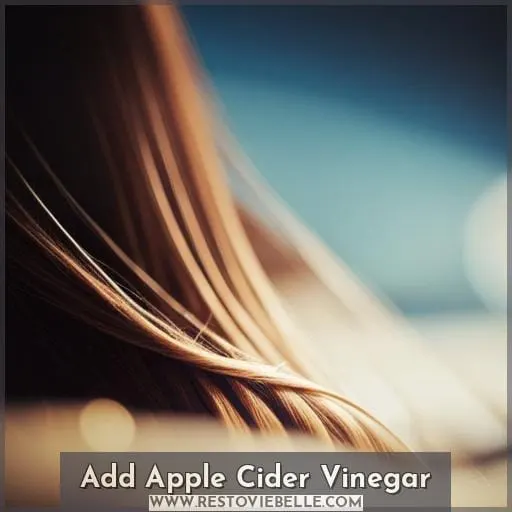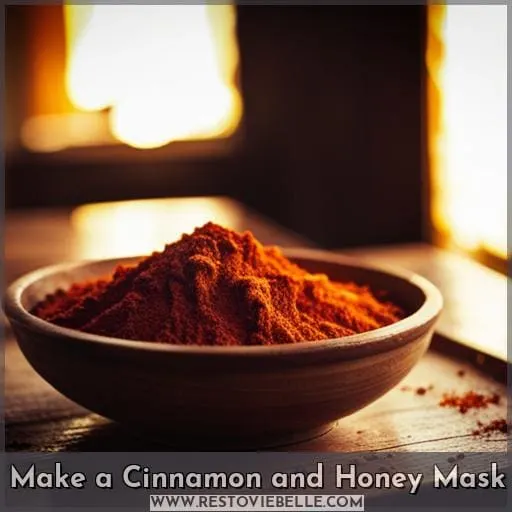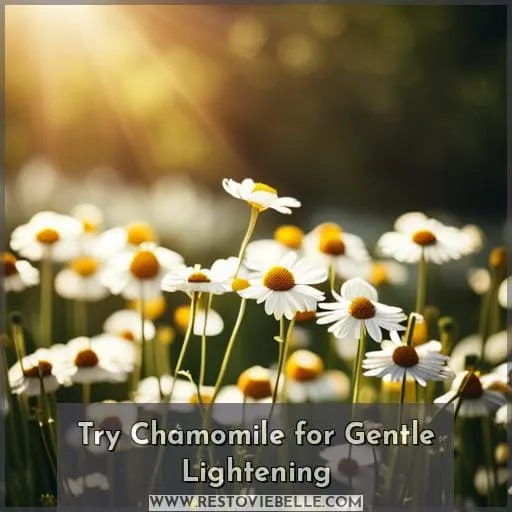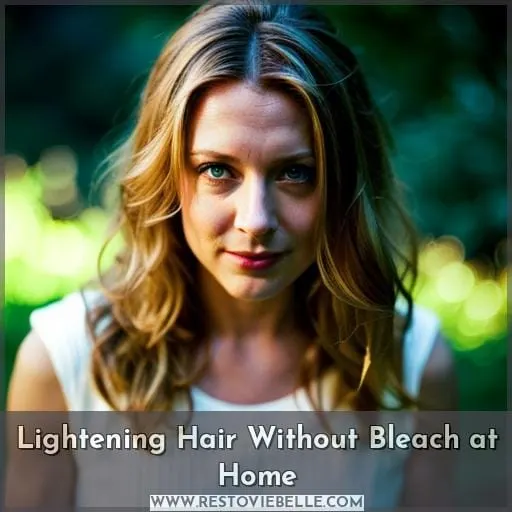This site is supported by our readers. We may earn a commission, at no cost to you, if you purchase through links.
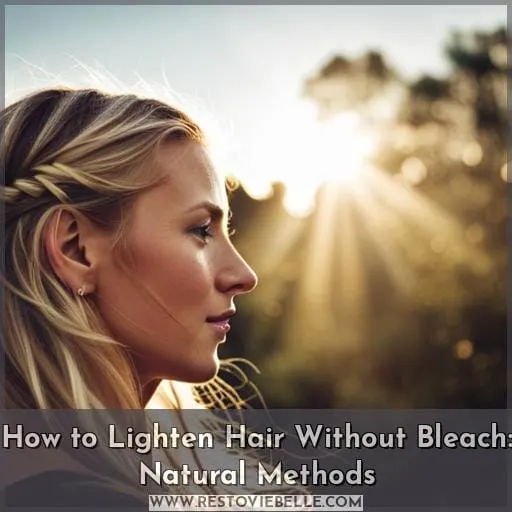 Ready to switch up your look without the use of harsh bleaches? If so, you’re in luck! Lightening your hair naturally is a great way to achieve luminous locks and give yourself a beautiful new style. With just a few items from around the house, you can lighten your hair using natural methods that won’t damage or weaken it.
Ready to switch up your look without the use of harsh bleaches? If so, you’re in luck! Lightening your hair naturally is a great way to achieve luminous locks and give yourself a beautiful new style. With just a few items from around the house, you can lighten your hair using natural methods that won’t damage or weaken it.
In this article, we’ll cover all the basics on how to lighten hair without bleach and provide some tips for maintaining healthy-looking color afterward.
Table Of Contents
- Key Takeaways
- Mix Lemon Juice With Conditioner
- Apply Vitamin C to Hair
- Use a Saltwater Solution
- Add Apple Cider Vinegar
- Combine Baking Soda and Hydrogen Peroxide
- Make a Cinnamon and Honey Mask
- Try Chamomile for Gentle Lightening
- Use Beer or Vodka as a Rinse
- Take Precautions When Using Sun-In
- Lightening Hair Without Bleach at Home
- Conclusion
Key Takeaways
- Mix lemon juice with conditioner for natural highlights.
- Apply vitamin C to hair for salon-worthy lightening.
- Create a saltwater solution for natural highlights.
- Combine baking soda and hydrogen peroxide for safe lightening.
Mix Lemon Juice With Conditioner
Transform your hair with a nourishing, lemon juice and conditioner mixture to naturally bring out its beautiful highlights! Citrus lightening is an all-natural way of brightening up dark or dull locks.
The addition of beneficial ingredients from the conditioner helps prevent damage as you lighten without using bleach.
This simple technique can also be used for highlighting or ombre effects on lighter tresses too! Mixing together equal parts lemon juice and conditioning treatment creates a powerful blend that not only provides gentle bleaching but also adds extra hydration to thirsty strands.
For optimal results, use freshly squeezed citrus instead of store-bought varieties which contain added preservatives that can irritate sensitive scalps.
You may need several applications depending upon the desired result – start off lightly and work up gradually if needed; this will help prevent overprocessing in one go! Once you have achieved your desired shade, don’t forget about aftercare – make sure to keep hair hydrated by applying natural oils like coconut oil regularly post-treatment so it stays healthy looking and glossy while maintaining its new hue longer than usual.
Plus, regular trims are key for avoiding split ends caused by dryness due to citric acid exposure during coloring sessions at home – so get those scissors ready! With just some simple mixing skills plus patience & care – you’ll be able unlock healthier & brighter color transformations minus any harsh chemicals involved.
Apply Vitamin C to Hair
You can get salon-worthy results at home by applying Vitamin C to your hair! Reports show that it can lighten hair up to two shades in as little as 20 minutes. Using Vitamin C for lightening is a natural and budget-friendly method compared to other traditional options like bleach or dyeing.
- It’s easy – just mix the powder with water, apply it directly on wet or dry hair, and leave it for 15-20 minutes.
Hair color enthusiasts claim that when used correctly, vitamin C helps keep your locks healthy while still achieving desired effects. Many people have noticed less damage from harsh bleaching products after using vitamin C treatments regularly due to its antioxidant properties, which help protect against oxidative stress caused by free radicals.
Vitamin C is an effective tool when you want lighter-looking locks without damaging them further with chemical dyes or bleach – especially if you already have colored strands of any kind! The benefits go beyond simply enhancing appearance; this remedy offers nourishment and protection from sun exposure too, making sure each strand remains strong even after repeated use of high-temperature tools such as curling irons and straighteners over time.
With proper application techniques along with low peroxide formulas combined bonding properties, professional guidance should be considered before attempting DIY methods so expectations are realistic but achievable safely and responsibly!
Use a Saltwater Solution
An alternative to bleaching your hair is using a saltwater solution, which can help bring out natural highlights and brighten your color without any harsh chemicals. Saltwater has many benefits for the hair—it helps remove build-up from styling products while hydrating strands.
But be aware that it’s important to protect your newly lightened locks with UV protecting products as sun exposure can cause fading of the new, lighter shade of color. Lemon juice should also be diluted when used in combination with saltwater because its high acidity may cause damage over time if not properly balanced by hydration and care.
When considering different natural methods for lightening hair, having an understanding of one’s individual hair type will ensure the best results are obtained based upon unique needs. There are pros and cons associated with each method, so it’s wise to review various tips on how they affect different types before attempting anything drastic at home.
With careful consideration, you can use these natural alternatives safely while still achieving desired looks—from subtle differences in tone or dramatic changes in hue!
Add Apple Cider Vinegar
Try adding some apple cider vinegar to your saltwater solution for an added boost of lightening power! Apple Cider Vinegar (ACV) is a natural hair lightening agent with many benefits. Not only does it help to lighten the hair, but it also helps nourish and condition the strands.
Its acidic properties can help remove product buildup from styling, making it ideal for DIYers who want to keep their locks healthy while they achieve their desired color. When used in combination with other natural ingredients like lemon juice or honey, ACV adds extra strength and boosts results when you’re looking for lighter hues without using bleach.
Additionally, ACV is gentle enough on all types of hair, so you don’t have to worry about damage caused by harsh chemicals or bleaches – plus it’s cost-effective! Before deciding which option works best for your individual needs, though, be sure to consider factors such as porosity levels and the current shade of your tresses.
This will influence how well any alternative methods may work on certain types of hair textures.
With these tips in mind, though, along with patience, anyone can get closer to obtaining those beautifully brightened locks minus damaging bleaching agents!
Combine Baking Soda and Hydrogen Peroxide
Combining baking soda and hydrogen peroxide is an effective way to safely brighten your beautiful locks without the harshness of bleach.
- Diluting both ingredients with water before application.
- Applying a hair mask or conditioner afterwards for added hydration.
- Avoiding contact with eyes and skin while working with these products.
- Not overusing as it can cause damage if left on too long.
This combination offers several benefits that make it a great option for lightening your hair without bleaching. It can add subtle highlights and enhance existing colors like blonde tones or reds in darker shades of hair color.
When used properly, this non-bleach formula provides fantastic results at home without having to visit a salon professional – perfect for those seeking natural solutions instead! Additionally, you may want to use specific products tailored towards your unique hair type considerations.
Overall, combining baking soda and hydrogen peroxide is an excellent way to achieve lighter colored locks naturally – no bleach necessary!
Make a Cinnamon and Honey Mask
You can make a natural, nourishing cinnamon and honey mask to help lighten your hair without bleach. This at-home treatment has been reported to be up to 50% more effective than other alternatives for naturally lightening hair! Cinnamon is known for its antioxidant and anti-inflammatory benefits, while honey adds additional moisturizing qualities.
When combined with the right ingredients in an easy DIY hair mask recipe, you can achieve lighter locks without bleaching or damaging your tresses.
Before getting started on this project, it’s important to consider the type of hair you have so that the results are optimal. Is your hair fine or thick? Curly or straight? Dark blonde, light brown, or black? It’s also essential to take precautions when using any product on your scalp, especially one containing cinnamon due to its strong scent.
Remember to wear gloves and avoid contact with your eyes. Additionally, test out a small patch of skin before applying it all over, as allergies may occur if too much cinnamon is used in combination with certain oils such as olive oil, which could cause irritation.
Once you’re ready, mix 1 tablespoon each of ground cinnamon powder (or organic powdered bark) along with raw honey into 2 tablespoons of coconut oil until a smooth paste forms. Then, apply the mixture onto dampened strands evenly from roots to tips, making sure not to leave any clumps behind.
Leave the mixture to sit for 15 minutes, ensuring to wrap your head with a warm towel to prevent steam from leaving and to allow your body heat to activate the properties within the mixture, which will better assist in breaking down melanin follicles.
Lastly, rinse your hair by shampooing twice and using conditioner afterwards. Use cool water to avoid stripping away the moisture you just added.
Try Chamomile for Gentle Lightening
Chamomile tea is a gentle way to enhance your natural hair shade. This herbal infusion contains flavonoids, which are known for their antioxidant properties.
To make a DIY chamomile recipe, steep two tablespoons of dried flowers in one cup of water for 15 minutes. Then, strain the liquid into an applicator bottle or spray bottle. Apply this mixture directly to dampened hair and let it sit on strands for 20-30 minutes before rinsing out with warm water.
For added benefits, you can mix the chamomile tea with lemon juice or conditioner. You can also use vitamin C powder or clarifying shampoo instead of a saltwater solution.
Chamomile also boasts anti-inflammatory qualities that will leave you feeling calm after its application. This is unlike harsher options like bleach, which can cause irritation if used excessively without cautionary measures in place first.
When compared to other natural lightening alternatives such as lemon juice alone, using chamomile offers great protection from potential damage due to its gentler nature. This makes it an ideal choice for those looking to achieve lighter locks without damaging their mane’s structure over time.
Use Beer or Vodka as a Rinse
Unlock a natural glow and show off your hair’s inner beauty by using beer or vodka as a rinse. Both have benefits for lightening the hair, but should be used with caution depending on the individual’s hair type.
Beer is known to add shine to dull or lifeless strands while infusing them with vitamins B and H, which lend themselves to healthier-looking locks. Vodka can help reduce red tones in darker shades of brown while also providing additional highlights.
To use vodka, apply it directly from the bottle onto dampened strands and rinse out after fifteen minutes of processing time.
When considering either one, it’s important to dilute any strong alcohol content to avoid possible damage from over-exposure. Even though both are considered non-bleach options for lightening, caution is still necessary.
If using beer specifically, it pays dividends to mix it with lemon juice and conditioner before application. This combination produces greater results than relying on beer’s strength alone.
Consider saltwater solutions as an alternative option, although they require more frequent applications compared to other techniques mentioned here. Keep in mind that different types of beers may yield different levels of success or failure when attempting at-home treatments.
Therefore, consulting professionals about suitable products tailored to your specific needs is essential before taking action yourself.
Take Precautions When Using Sun-In
When using Sun-In, it’s important to take precautions for optimal results and minimal damage. UV protection is essential as exposure to the sun can cause further lightening of your hair but also potential lasting damage.
Ensure that you use a leave-in conditioner with sunscreen built in after each treatment.
Hair hydration should be prioritized during this process, so opt for deep conditioning treatments at least twice a week and an intensive moisturizing mask once per month throughout the duration of your lightening journey with Sun-In products.
Additionally, start off slowly by using smaller amounts more frequently instead of larger doses less often to avoid overdoing it and causing major harm or disappointment due to unexpected results from too much product being used all at once without monitoring progress along the way.
Taking these precautionary measures will help ensure that you achieve desired lighter locks safely!
Lightening Hair Without Bleach at Home
If you’re considering lightening your locks without the hassle of bleach, there are a few at-home alternatives to consider. DIY hair lightening involves natural ingredients such as lemon juice and conditioner, apple cider vinegar, honey mixtures, and chamomile tea rinses.
Consider safe methods for achieving sun-kissed strands. For example, mix half a cup of raw honey with two tablespoons of cinnamon powder to create an effective mask.
Lighten your hair naturally by combining equal parts lemon juice and water in a spray bottle.
To brighten tresses further, mix equal parts organic coconut oil with 1/4 cup baking soda for an exfoliating scrub. Alternatively, you can use one part hydrogen peroxide mixed into four parts water.
At-home lightening is possible but requires careful consideration when selecting products or treatments. It is recommended to consult professionals if you are unsure about which method suits you best.
Conclusion
It’s possible to lighten your hair without resorting to bleach, but it’s important to understand the differences between the various natural methods. Lemon juice, vitamin C, saltwater solution, and apple cider vinegar can all be used, but it’s important to be aware of the potential damage these can cause to the hair if not used correctly.
It’s also important to remember to take into consideration the condition of the hair before lightening and to ensure that the hair is hydrated and cared for afterwards. With professional guidance and the right products, you can lighten your hair without bleach and still achieve desirable results.




